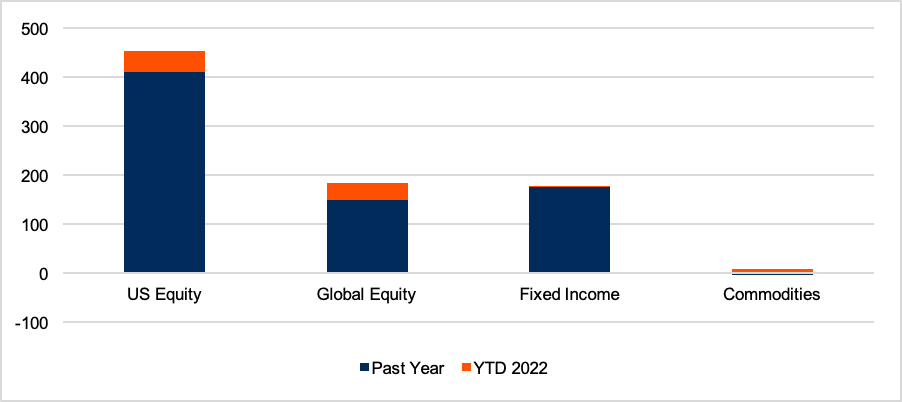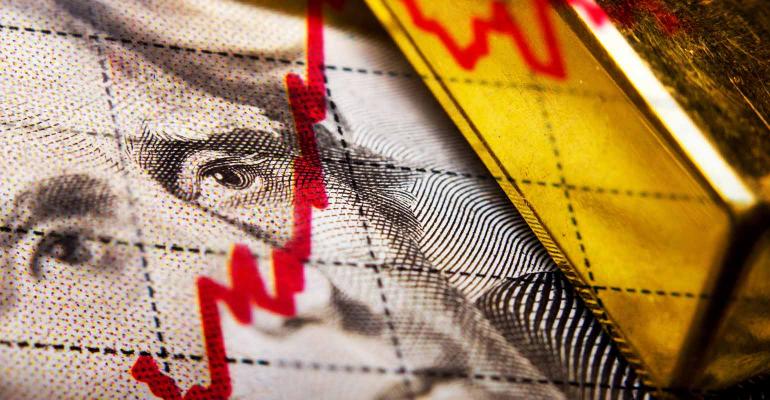Commodities ETFs have provided a safe haven for investors thus far in 2022. During the record-setting year of net inflows in 2021, ETFs that invested directly or in futures contracts tied to the price of precious metals, energy, agriculture, or a diversified basket of commodities missed out with investors significantly favoring equity or fixed income products. However, with increased inflationary concerns, the specter of rising interest rates, and elevated geopolitical concerns, commodities-focused funds have been in vogue in 2022.
Year to date through Feb. 25, commodities ETFs gathered $8.5 billion of net ETF inflows, equal to nearly 10% of the industry’s total cash haul and erasing the prior outflows in the past year. In the same period, fixed income ETFs pulled in just $1.3 billion of new money. Thus far in 2022, led by broad market products used often for asset allocation strategies, U.S. equity and global equity ETFs received $42 billion and $35 billion of net inflows, respectively.
Figure 1: ETF Asset Class Focused Net Inflows ($B)

CFRA’s ETF database. As of February 25, 2022
Precious metals ETFs shined the brightest but were not alone. ETFs investing in gold and other metals gathered $4.8 billion year to date through Feb. 25, led by $3.1 billion into SPDR Gold Shares Trust (GLD), which remains the largest commodity ETF with $62 billion in assets. However, fellow gold ETFs iShares Gold Trust (IAU), iShares Gold Trust Micro (IAUM) and Goldman Sachs Physical Gold ETF (AAAU), as well as iShares Silver Trust (SLV), were among the commodities ETFs to pull in more than $200 million of new money to start the year. AAAU, IAU, and IAUM charge lower expense ratios than GLD, though they have more modest average daily volume.
Investors also embraced a broader approach to obtaining commodities exposure by putting $3.6 billion into diversified commodities ETFs. For example, Invesco Optimum Yield Diversified Commodity Strategy No K-1 ETF (PDBC) gathered $1.7 billion of net inflows to start the year, second only to GLD among commodities ETFs. PDBC owns futures contracts on 14 commodities across the energy, precious metals, industrial metals and agricultural sectors, such as aluminum, corn, gold, wheat and WTI crude. Diversified commodity ETF peers First Trust Global Tactical Commodity Strategy Fund (FTGC) and Invesco DB Commodity Index Tracking Fund (DBC) gathered an additional $1.2 billion this year.
Meanwhile, investors have pulled back from gold miner ETFs in 2022 but favored energy-focused equity funds. VanEck offers two popular ETFs that invest in precious metals companies such as Barrick Gold, Evolution Mining Limited and Newmont Corp., which stand to benefit from higher commodities prices. Yet, in 2022, VanEck Gold Miners ETF (GDX) and VanEck Junior Gold Miners ETF (GDXJ) incurred combined net outflows of $375 million and $60 million, respectively.
In contrast, Energy Select Sector SPDR Fund (XLE), which owns large-caps such as Chevron and Exxon Mobil that will gain from higher energy prices, has received $1.9 billion of new money this year.
Conclusion
Demand for commodities-focused ETFs has returned in 2022 after such funds were largely out of favor in 2021. While higher commodity prices can be a catalyst for certain equity ETFs, we encourage investors to understand the risk and reward of the stocks inside before putting money to work.
Todd Rosenbluth is the director of ETF and mutual fund research at CFRA. Learn more about CFRA's ETF research here.





